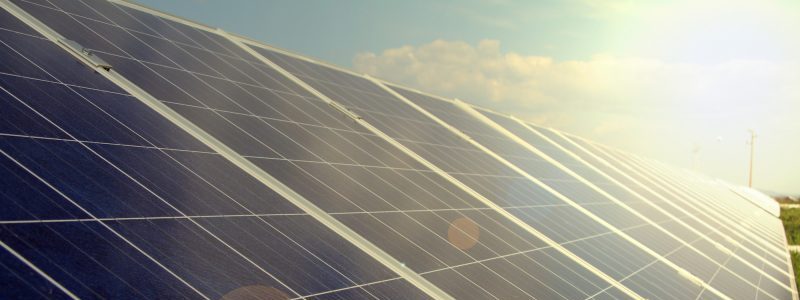Virtual Power Purchase Agreement 101
November 30, 2021

More now than ever, companies are looking to improve their environmental footprint, and many are turning to power purchase agreements (PPAs). PPAs are highly appealing as they offer companies without renewable energy expertise a way to get into clean energy production. However, many companies need additional flexibility because of constraints like location, financing, or time–and that’s where virtual PPAs (VPPAs) come in.
There are two types of PPAs. There are onsite PPAs that have traditionally been more popular, and VPPAs that are now gaining tremendous popularity. Here we will focus on VPPAs: how they work, their place in the renewable energy procurement market, and why they have gained traction in recent years.
Physical PPAs vs. Virtual PPAs
Under a PPA framework, a commercial solar energy customer agrees to buy electricity from a solar developer who develops a solar array on the customer’s facility. The developer then sells the energy produced by the system to the customer at a predetermined rate for the duration of the contract (typically 15-25 years).
A virtual PPA replicates the financial contract of a traditional PPA but with one major distinction: the clean energy project is sited offsite. It is essentially a “financial swap,” exchanging a fixed-priced cash flow for a variable-priced cash flow plus renewable energy certificates (RECs).
In sum, virtual PPAs offer a few unique advantages:
- No construction necessary
- VPPAs are not tied to geography and can move with your business
- Immediate reduction in carbon footprint
- Supplement clean energy production when your energy needs can’t be met with onsite solutions alone
How VPPAs Work
For customers looking to take part in the clean energy economy, procurement of VPPAs offer a convenient option, all while allowing customers to preserve their capital. Customers retain a relationship with their local electric provider while supporting the production of an agreed-upon amount of clean energy through their VPPA contract. This then provides the company with commensurate RECs, where each REC represents one megawatt hour (MWh) of clean electricity. Thus a company can support renewable energy development through the operation of their business without dealing with the practical demands of hosting actual clean energy infrastructure on their facilities.
Electricity purchased through a VPPA is not physically delivered to your facility. Instead, that clean energy is delivered to the power system in the immediate vicinity of the solar or wind farm. A strike price for electricity is laid out in each contract, and if the market price is below the price agreed upon in the VPPA, the customer will cover the price differential. When the strike price is equal to the market price, no additional change is needed. When the market price is above the strike price, then the project will pay out the difference to the VPPA holder. Over the lifetime of a typical contract, the market price for electricity will be above the strike price laid out in the VPPA, thus setting up the customer to walk away from the contract making money. Many customers will choose to take this revenue payout and put it towards payment of their regular utility bill. In this way, the customer is able to financially benefit from the low cost of renewable energy. Through VPPAs, companies can better plan ahead for their electricity expenses and hedge against future increases in electricity prices.
The Role of VPPAs in Renewable Energy Procurement Market
VPAAs offer the ability to procure renewable energy from offsite locations which are better suited to wind or solar production and can engage in more cost-effective large-scale production. The physical introduction of solar infrastructure may not be an option for some companies due to the structure or location of facilities, uncertain occupancy duration, or building lease restrictions. VPPAs present businesses under these circumstances the opportunity to participate in the clean energy economy when external limitations would otherwise prevent them. For companies working on long-term projects to supply their operations with clean energy, VPPAs can offer a way to get started on decarbonization goals in the interim.
Why VPPAs Are Increasing in Popularity
Shifts in consumer culture are motivating companies to set ambitious climate goals, including reducing their carbon footprint and powering their operations through clean energy. According to a 2020 report from Deloitte, consumers are prioritizing purchasing from companies whose values reflect their own, particularly when it comes to environmentalism and sustainability. 79% of consumers report changing their purchasing behavior based on social responsibility, inclusiveness, and environmental impact, as documented in a report from the Capgemini Research Institute. But these things take time and physical resources companies may not have. VPPAs can help to fill this gap, allowing companies to easily and quickly meet this shift in consumer demand, securing and increasing market share among the environmentally conscious consumer.
Many recent reports have documented the value of a “green” company reputation in attracting Millennial and Gen Z talent, but a study from the Charlton College of Business at the University of Massachusetts-Dartmouth reveals that incorporating sustainability into your company actually offers benefits across generations. Employees who view their company as more environmentally friendly report greater satisfaction with their jobs.
Find out if a VPPA is Right for Your Company
VPPAs can allow companies to claim credit for contributing to the broader economic and environmental impacts associated with clean energy. This includes supporting good jobs in the clean energy sector, supporting state and local tax revenues, reducing air pollution, contributing to better water quality, and of course fighting climate change.
If you are interested in learning more about whether a VPPA makes sense for your business, the seasoned experts at Pivot Energy are here to help. Contact us today!

.jpg?width=123&name=Angie%20Agrivoltaics%20Award%20(HQ).jpg)


.jpg?width=400&name=Angie%20Agrivoltaics%20Award%20(HQ).jpg)
